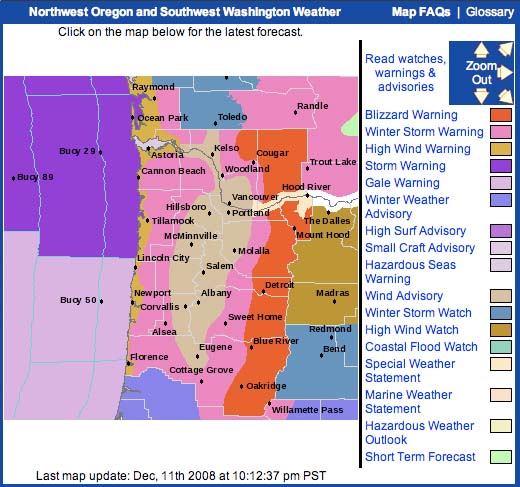

Colorful forecast maps make me happy, especially since there’s a good chance we’ll see some snow out of the latest batch of storms.
I awoke early, at about 6:30 AM at the first hint of the morning twilight. I could hear dry leaves swirling about on the patio outside, and my bedroom (unheated, as I normally keep it) felt colder than normal. That must mean the cold east wind had arrived. I pulled up another blanket and dozed back to sleep.
An hour later, I awoke again and could tell I wasn’t going to fall back asleep. So I got up to check the thermometer. I open the door and snowflakes were already gently swirling down and coating the ground in white. The thermometer read 29 ˚F (-2 ˚C).
It’s been snowing lightly all day. Not much more than an inch has fallen here near sea level, but the temperature has fallen as the day has worn on, and it’s now very nice snow that’s falling: relatively dry and fluffy. Rocky Mountain residents would still call it wet snow, of course, but it’s quite a ways removed from the barely-frozen sloppy snow that usually is all we get in the Pacific Northwest.
Even better yet, the light is changing in ways it hasn’t since the last cold snow in 2004 (which was truly wonderful, dry, cold snow, at least before it changed to sleet and freezing rain). It’s getting that cold, wintry bluish color to it.
I walked up to about the 500 foot level in the West Hills. The hills make their own weather and get significantly more moisture than the flats nearby. True to that pattern, there was more snow on the ground and it was falling harder. In the old growth grove at the Pittock Bird Sanctuary, the falling flakes were getting intercepted by the boughs 200 feet above and broken into fine shards that sifted down like talcum powder, dusting the Oregon grape and the deep, furrowed bark of the ancient Douglas-firs in exquisite detail.
Because it was above freezing yesterday, the epiphytic licorice ferns had yet to get blasted by the cold. Maple and alder trunks bore mini-snowscapes which had accumulated on their hanging moss and fern gardens.
Just above me, I could hear the sound of wind rushing through branches. Not much point in continuing on to the Pittock Mansion at the 950 foot level; doubtless there’s a blizzard going on up there. Gently falling snow that turns deciduous trees and shrubs to lace is pretty to walk in; a raging blizzard with wind-chills in the single digits, not so much.
I walked back mostly through the residential streets of the West Hills. Teenagers were having great fun taking very long sledding runs down hundreds of vertical feet of winding snowpacked streets.
The freezing weather is supposed to last until next weekend (maybe even longer), with at least one more chance for snow, so it’s going to be an interesting week. It hasn’t been this cold that long in nearly twenty years.
Deep down inside, who wouldn’t want to do something like this if they could? I believe the only reason it hasn’t happened before is the prospect of serving some time in the clink.
Hats off to Muntadar al-Zaidi!
Taken this morning. I was surprised at how it’s almost completely roofed over with ice in places. It shows just how cold it’s been getting at night. The coldest my thermometer (near my building, and doubtless affected by heat leaking from it) was 19 ˚F. It’s obviously gotten colder than that away from the building.
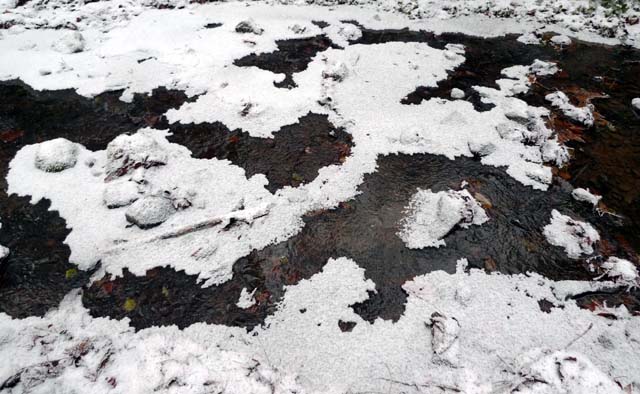
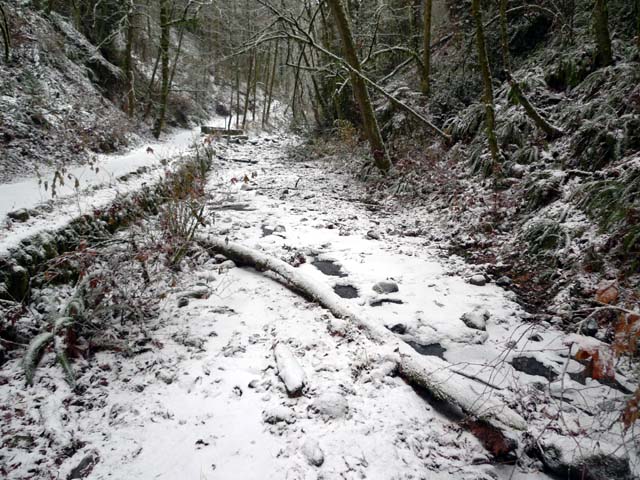
Yesterday night was very trippy as the snow came falling down, harder than I’ve ever remember it fall in Portland, all the while the temperature fell to 19 ˚F and the snow became drier and colder.
When I’m sleeping and I have one too few blankets, I often won’t wake up but instead will incorporate the cold into my dreams, even if the dream is situated (as it usually is) in the lowlands of the Pacific Northwest, which rarely see heavy falls of snow, and even more rarely sees cold, dry snow. Yet there it was, falling down, in real life, just outside the window of my Portland apartment. And it sparkled like diamonds under the streetlights, just like I remember snow doing in the Rockies. We ended up with eight inches just before it changed over to a very un-Rockies-like freezing drizzle.
Balch Creek is now almost completely frozen over. Even the little waterfalls have frozen over vertically with intergrown icicles, the water continuing to fall behind the curtain of ice:
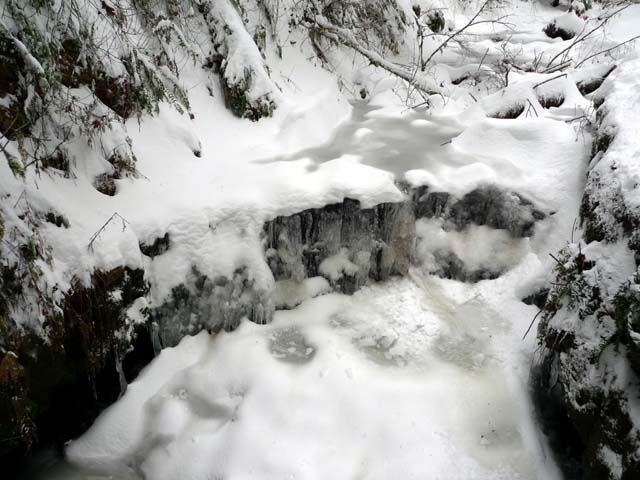
The freezing drizzle changed back to snow this afternoon, and nearly two more inches fell. More is forecast to come before daybreak.
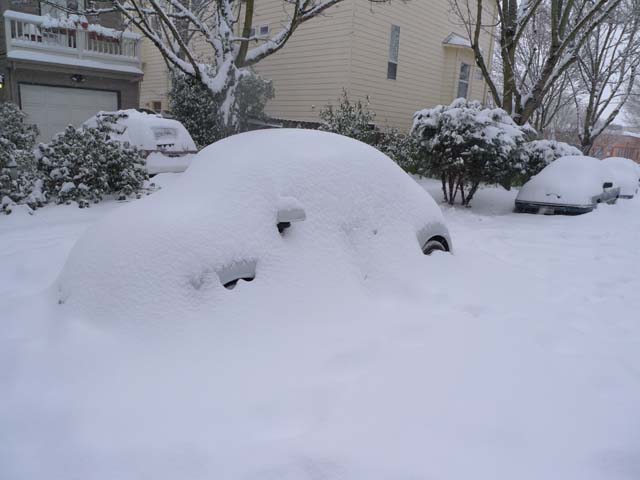
The snow promised to fall on the night of the 21st did. Frankly, this is getting a little bit ridiculous for the lowlands west of the Cascades. But not unprecedented: I’ve seen big snows three times before since moving to the Northwest.
As I write this, it’s beginning the process of turning into a slushy mess and disappearing, though it’s going to be a protracted one, given the amount we’ve received and how the thaw is supposed to come in fits and starts. There’s a very good chance of breaking the old monthly snowfall record for December before it’s all over.
The snow is mostly melted now, and what has left is melting rapidly.
While it was clogging the streets, there was no shortage of opinions comparing Portland’s lacking response to what one would see in, say, Chicago. Frankly, that’s silly. Chicago gets much more snow than we do. The last time there was 10+ inches of snow on the ground here was 1992. Before that, it was 1982. And the total snowfall over the ten-day cold period made this December the snowiest one ever.
Clearly, we’re not dealing with normal weather here. Investing in the sort of equipment needed to remove such snow would be an extravagance for Portland.
It’s how Chicago handles things, too. Sure, they can deal with a foot of snow no problem. But what about two or three feet? Last time they had a winter like that, it caused major problems. Cities base their snow-removal equipment inventory on the worst storm they can expect to see every few years. They don’t base it on the worst storm they can expect to see every few decades.
At the same time, it should be abundantly clear that Tri-Met’s snow response needs improvement. By Sunday night, with eight-plus inches of snow on the ground and more falling from the sky, it should have been clear that the normal service obligations wouldn’t be achievable. They should have scaled back to the frequent-service routes right then and there.
That’s especially the case because — motivated by fears of big snowfalls that failed to materialize earlier — the buses had been running on chains on bare pavement for most of the preceding week. It’s hardly a big secret that doing this is hard on chains. Not surprisingly, by the time the chains were really needed, they were breaking. In other words, the number of buses capable of providing service was already reduced. Reducing service to compensate is simply common sense.
It’s also obvious that management screwed up big-time and failed to properly train or communicate with drivers. On Monday morning — when buses were officially on snow routes — numerous buses were getting stuck on NW Wardway and NW Nicolai. According to Tri-Met’s own snow routes, buses shouldn’t have been on either street.. Bus drivers were stopping and asking each other where to go.
I waited over 30 minutes for buses that never came at Montgomery Park, because that’s where the route map showed all the snow routes going. On Tuesday, I saw a bus traveling on Thurman St., despite all the long-existing snow route maps showing no service on that street, either, and Tri-Met’s own service announcement for that route clearly stating “no Thurman.” That’s right: as a passenger, I had a better idea of where the snow routes went than the drivers. There is quite simply no valid excuse for this.
As for MAX, Tri-Met should have been prepared to shut the Yellow Line down and replace it with buses ahead of time. The wye where the Yellow Line breaks off from the main line is in a paved street. It is not possible to install heaters on such switches. Therefore, it should have been obvious the switches were doomed to freeze. We should be thankful they didn’t freeze in the other position and force the closure of the main line.
The loss of the Red Line service due to similarly frozen switches can, however, be excused. Those switch heaters failed because of high wind and heavy snowfall. The unusual nature of such winter storms means this was the first opportunity to really test them since they were installed in the wake of the 2004 snow/ice storm. It’s probably worth investigating how snowy, windy places like Chicago and Winnipeg keep switches in service year-round. My guess is that it would take fairly minor modifications (to only a few switches) to keep the Red Line (and the soon-to-open Green Line) in service during the next big snow.
Monthly Index for 2008 |
Index of Years